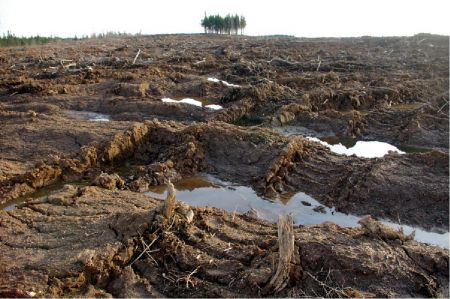K'JIPUKTUK, HALIFAX - When a government-assembled team of scientists and other experts set to work to identify ecologically sensitive areas within a large tract of Western Nova Scotia forest lands, it didn't expect to see its recommendations ignored by the Department of Natural Resources.
But two reports released after a Freedom of Information request by the Ecology Action Centre (EAC) suggest that is exactly what happened.
In an initial report the government experts identified important fish and wildlife habitats, the presence of species at risk such as the mainland moose, and uncommon or sensitive ecosystems.
When those recommendations were not reflected in a draft resource management plan some of the civil servants issued a second report.
"Several areas of high biodiversity values ... are not aknowledged," the scientists complain, adding that "these omissions occur disproportionately where lands of high biodiversity value overlap lands of high forestry value."
"The key concern here is that the priority given to forestry in these areas is presented as the outcome of an integrated and balanced planning process, when it appears that in reality biodiversity was simply devalued where it might impinge on forestry interest if accommodated," the report continues.
Western Nova Scotia contains roughly 1.5 million acres of Crown Lands. This includes the 550,000 acres of Bowater-Mersey lands the province acquired from Resolute Forest Products Ltd. in late 2012.
The province intends to lease lands not deemed ecologically sensitive to Nova Scotia's struggling forestry industry, possibly as early as this summer.
For Matt Miller, Forestry Coordinator at the EAC, the scientists' complaints are further evidence that Natural Resources is not listening to the many stakeholders who asked for sustainable forestry practices and more inclusive consultation during last year's public consultations.
"The province is less collaborative than ever on some forestry issues," Miller tells the Halifax Media Co-op. "In terms of enduring and effective long-term stakeholder engagement processes there is less now than there ever was."
The biologists not only complain about being ignored, they also provide examples.
In the so-called St. Margaret's Block, bordering the St. Margaret's Bay and not that far from Halifax, the scientists warn agains major forestry activities because it could negatively impact the mainland moose.
They also mention the presence in that same area of a coastal red spruce forest zone, important brook trout habitat, and the Ingram River watershed, one of the last publicly owned large and free-flowing watersheds in Western Nova Scotia.
Miller mentions an area that encompasses Digby and parts of Yarmouth Counties as a particularly striking example of DNR's bias towards the forestry sector. "There are some area in there that the committee describes as richer in biodiversity acre-for-acre than the vast majority of Crown lands in the province," says Miller.
When asked to respond by the Chronicle Herald, Zach Churchill, the Minister of Natural Resources, argues that you can't please everybody and biodiversity considerations need to be balanced with economical and social factors.
"Our goal has been obviously to approach this sort of issue through a lens that encompasses all three of those, and I really think that we’ve done a good job achieving that balanced approach,” Churchill tells the Chronicle Herald.
The minister also argues that so-called light touch harvesting remains an option in some of the areas designated as open for forestry activities.
Miller is not impressed.
"I would love to be able to give you a firm professional judgment on the decision framework that the government has in place, but the fact is, I don't know what it is, they haven't shared it," says Miller.
The same response applies to the policies in place for light touch harvesting, Miller says.
Apart from high-level principles and guidelines the department has never shared its detailed on-the-ground regulations that would apply to light touch harvesting, Miller argues.
"The minister can claim that there are all these great policies in place, but without putting them on the table, how can we judge something that as of yet has not been developed or is not available for consultation," Miller asks.
Follow Robert Devet on Twitter @DevetRobert



